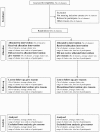A cluster randomised controlled trial of an occupational therapy intervention for residents with stroke living in UK care homes (OTCH): study protocol
- PMID: 22776066
- PMCID: PMC3436864
- DOI: 10.1186/1471-2377-12-52
A cluster randomised controlled trial of an occupational therapy intervention for residents with stroke living in UK care homes (OTCH): study protocol
Abstract
Background: The occupational therapy (OT) in care homes study (OTCH) aims to investigate the effect of a targeted course of individual OT (with task training, provision of adaptive equipment, minor environmental adaptations and staff education) for stroke survivors living in care homes, compared to usual care.
Methods/design: A cluster randomised controlled trial of United Kingdom (UK) care homes (n = 90) with residents (n = 900) who have suffered a stroke or transient ischaemic attack (TIA), and who are not receiving end-of-life care. Homes will be stratified by centre and by type of care provided and randomised (50:50) using computer generated blocked randomisation within strata to receive either the OT intervention (3 months intervention from an occupational therapist) or control (usual care). Staff training on facilitating independence and mobility and the use of adaptive equipment, will be delivered to every home, with control homes receiving this after the 12 month follow-up.Allocation will be concealed from the independent assessors, but the treating therapists, and residents will not be masked to the intervention. Measurements are taken at baseline prior to randomisation and at 3, 6 and 12 months post randomisation. The primary outcome measure is independence in self-care activities of daily living (Barthel Activities of Daily Living Index). Secondary outcome measures are mobility (Rivermead Mobility Index), mood (Geriatric Depression Scale), preference based quality of life measured from EQ-5D and costs associated with each intervention group. Quality adjusted life years (QALYs) will be derived based on the EQ-5D scores. Cost effectiveness analysis will be estimated and measured by incremental cost effectiveness ratio. Adverse events will be recorded.
Discussion: This study will be the largest cluster randomised controlled trial of OT in care homes to date and will clarify the currently inconclusive literature on the efficacy of OT for stroke and TIA survivors residing in care homes.
Trial registration: ISRCTN00757750.
Figures
References
-
- Legg L, Drummond A, Leonardi-Bee J, Gladman JR, Corr S, Donkervoort M, Edmans J, Gilbertson L, Jongbloed L, Logan P, Sackley C, Walker M, Langhorne P. Occupational therapy for patients with problems in personal activities of daily living after stroke: systematic review of randomised trials. BMJ. 2007;335:922. doi: 10.1136/bmj.39343.466863.55. - DOI - PMC - PubMed
-
- Yap LK, Au SY, Ang YH, Kwan KY, Ng SC, He CH. Who are the residents of a nursing home in Singapore? Singapore Med J. 2003;44:65–73. - PubMed
-
- Sprangers MA, De Regt EB, Andries F, Van Agt HM, Bijl RV, De Boer JB, Foets M, Hoeymans N, Jacobs AE, Kempen GI, Miedema HS, Tijhuis MA, De Haes HC. Which chronic conditions are associated with better or poorer quality of life? J Clin Epidemiol. 2000;53:895–907. doi: 10.1016/S0895-4356(00)00204-3. - DOI - PubMed
Publication types
MeSH terms
Associated data
Grants and funding
LinkOut - more resources
Full Text Sources
Medical


